The NVIDIA RTX A4000 is part of the company’s latest desktop professional GPU lineup meant for desktop workstations that need high-performance for real-time ray tracing, AI-accelerated compute, and high-performance graphics. Leveraging the second-generation RTX architecture, NVIDIA claims that the A4000 is the most powerful single-slot GPU available on the market for professionals.
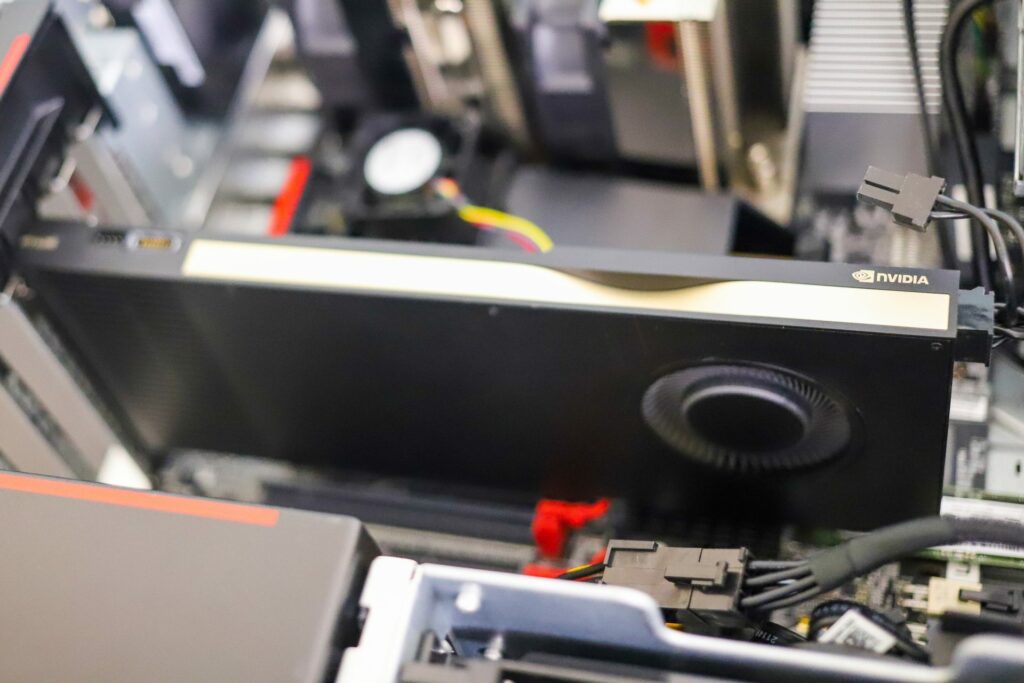
The A4000 sits right behind the RTX A5000 and RTX A6000 in NVIDIA’s new line of professional RTX cards, featuring 48 RT Cores (2nd gen), 192 third-generation Tensor Cores, and 6,144 CUDA cores with 16 GB of graphics memory. While NVIDIA dropped the Quadro name to distinguish their professional line, the RTX A4000 still features the same professional features, hardware and software certifications, certified drivers as the Quadro line was known for.
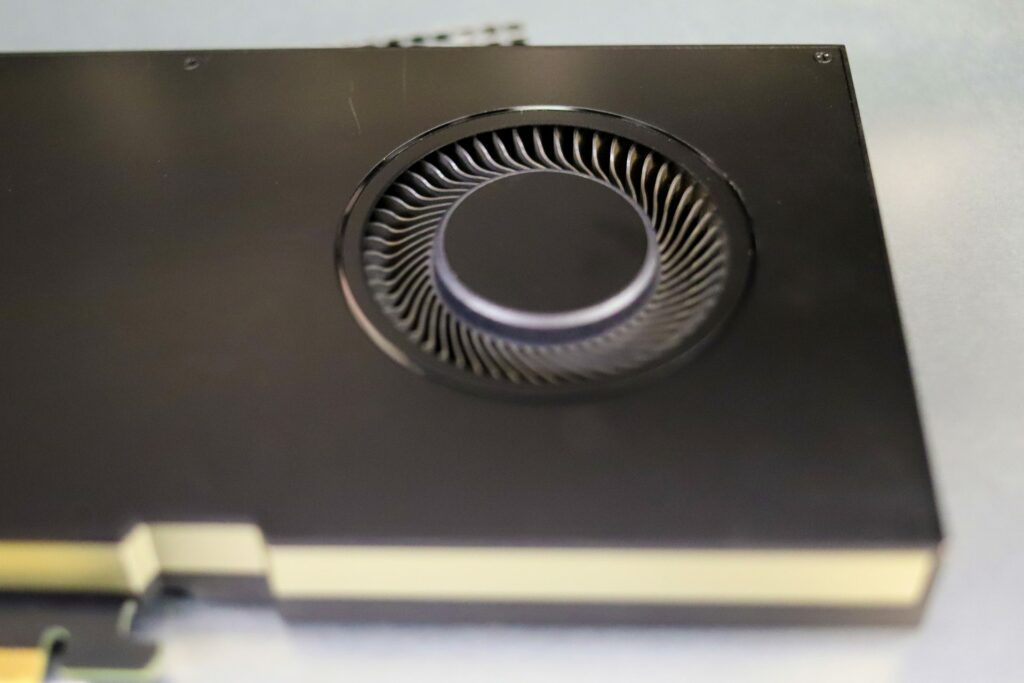
For connectivity, the 4.4” height x 9.5” length A4000 features four DisplayPort 1.4a ports and the usual 1x 6-pin PCIe power port. Ventilation runs along the top of each of the DisplayPorts and on the front side of the card, while a smaller fan resides on the opposite side.
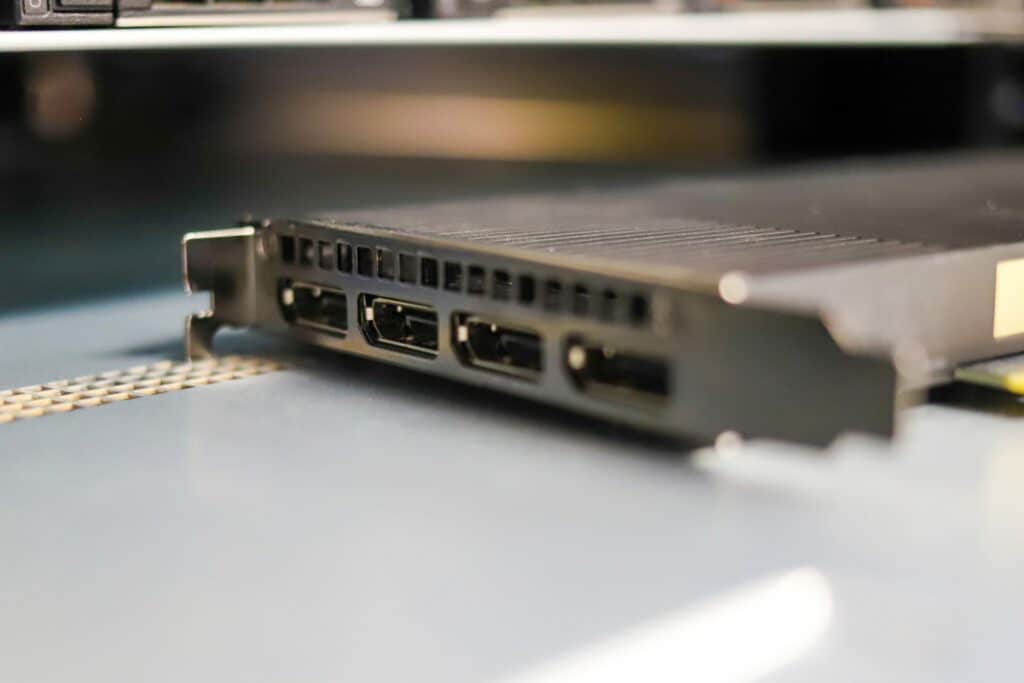
NVIDIA RTX A4000 vs Quadro RTX 4000
NVIDIA considers the RTX A4000 as a successor to the Quadro RTX 4000, an aging card that’s a few years old at the time of this review. In our review from 2019, the RTX 4000 posted some very impressive performance for an entry-level card, making it a great addition to the company’s impressive portfolio while carrying a price tag of roughly just $900 when it was released. That said, with the advancements NVIDIA has recently made in their GPU architecture, we’re always excited to see what they have in store for their workstation-class cards.
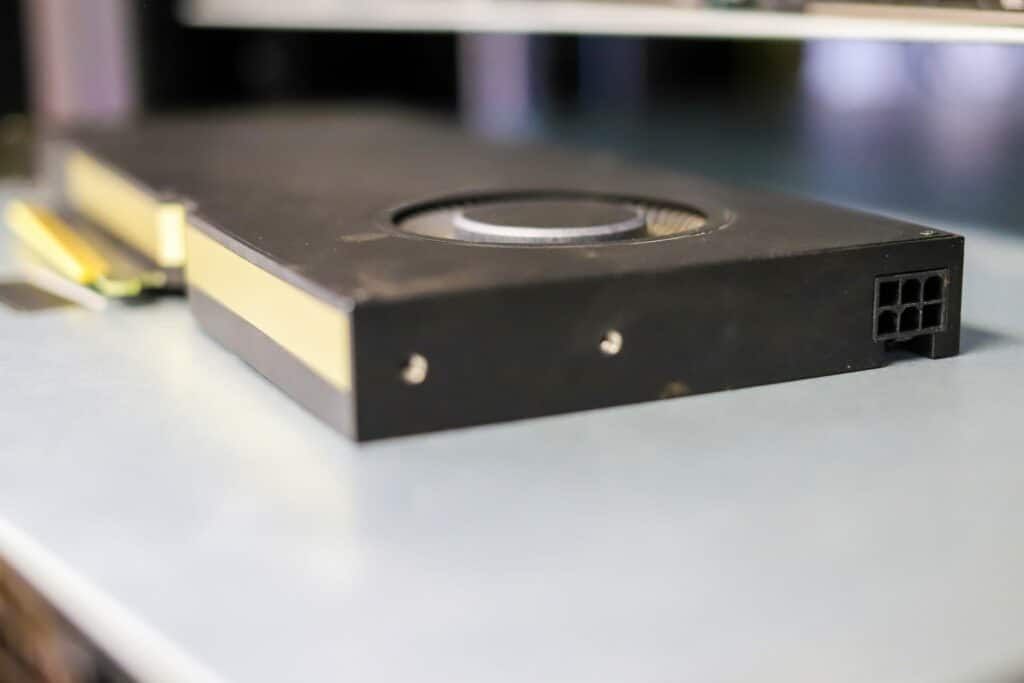
Right away you will see that the A4000 doubles the GPU memory of the Quadro card to 16GB and while almost tripling the CUDA core count. Coupling this with a slight increase in memory bandwidth (448GB/s), the new A4000 is already looking significantly better. These specs make it more in line with the RTX 3070, NVIDIA’s high-performance desktop consumer card.
NVIDIA Ampere
As we mentioned in our RTX A6000 review, the most significant upgrade to the company’s next-gen professional graphics cards is NVIDIA Ampere. This is where the true jump in performance lies. Highlights of this new architecture that leverages Samsung’s 8nm NVIDIA custom process with 28 billion transistors. It also features an improved streaming multiprocessor and second-generation Ray Tracing cores (which improve ray tracing hardware acceleration) and third-generation Tensor Cores, the latter of which improves AI inference performance and DLSS resulting in better performance in higher resolutions.
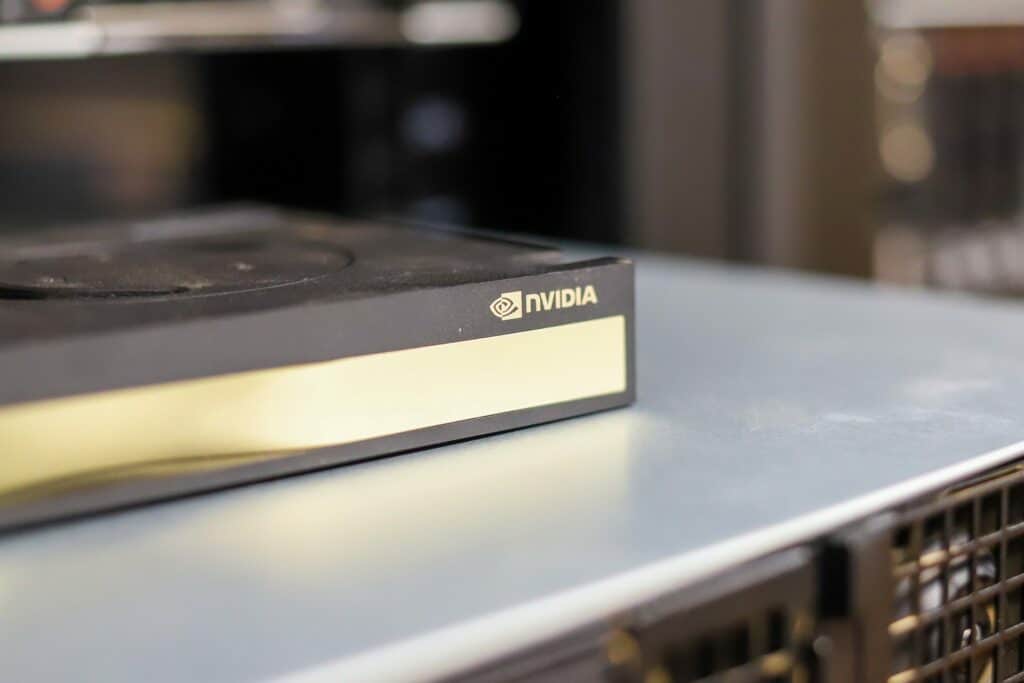
The Ampere architecture also increases CUDA cores by up to double the single-precision floating-point compared to last-gen models. This means noticeable performance improvements in areas such as 3D model development and tasks like desktop simulation for computer-aided engineering.
Backed by a 3-year warranty, the NVIDIA RTX A4000 goes for roughly $2,000 depending on the branding.
NVIDIA RTX A4000 Specifications
| GPU memory | 16 GB GDDR6 |
| Memory interface | 256-bit |
| Memory bandwidth | 448 GB/s |
| Error-correcting code (ECC) | Yes |
| NVIDIA Ampere architecture-based CUDA Cores | 6,144 |
| NVIDIA third-generation Tensor Cores | 192 |
| NVIDIA second- generation RT Cores | 48 |
| Single-precision performance | 19.2 TFLOPS3 |
| RT Core performance | 37.4 TFLOPS3 |
| Tensor performance | 153.4 TFLOPS4 |
| System interface | PCI Express 4.0 x16 |
| Power consumption | Total board power: 140 W |
| Thermal solution | Active |
| Form factor | 4.4” H x 9.5” L,
single slot |
| Display connectors | 4x DisplayPort 1.4a |
| Max simultaneous displays | 4x 4096 x 2160 @ 120 Hz,
4x 5120 x 2880 @ 60 Hz, 2x 7680 x 4320 @ 60 Hz |
| Power connector | 1x 6-pin PCIe |
| Encode/decode engines | 1x encode, 1x decode (+AV1 decode) |
| VR ready | Yes |
| Graphics APIs | DirectX 12.075, Shader Model 5.175,
OpenGL 4.686, Vulkan 1.26 |
| Compute APIs | CUDA, DirectCompute, OpenCL™ |
NVIDIA RTX A4000 Performance
To gauge its performance, we put the RTX A4000 through a series of resource-intensive tests and compared it to the higher-classed RTX A6000 to show you the differences between the two ends of the second-generation RTX architecture spectrum. We installed both the A4000 and A6000 inside a Lenovo ThinkStation P620 and HP ZCentral 4R for testing.
HP ZCentral 4R:
- Intel Xeon 2295 (3.0 GHz base frequency, up to 4.6 GHz with Intel vPro Technology)
- 64GB of DDR4-2933 ECC SDRAM
- 1TB M.2 SSD
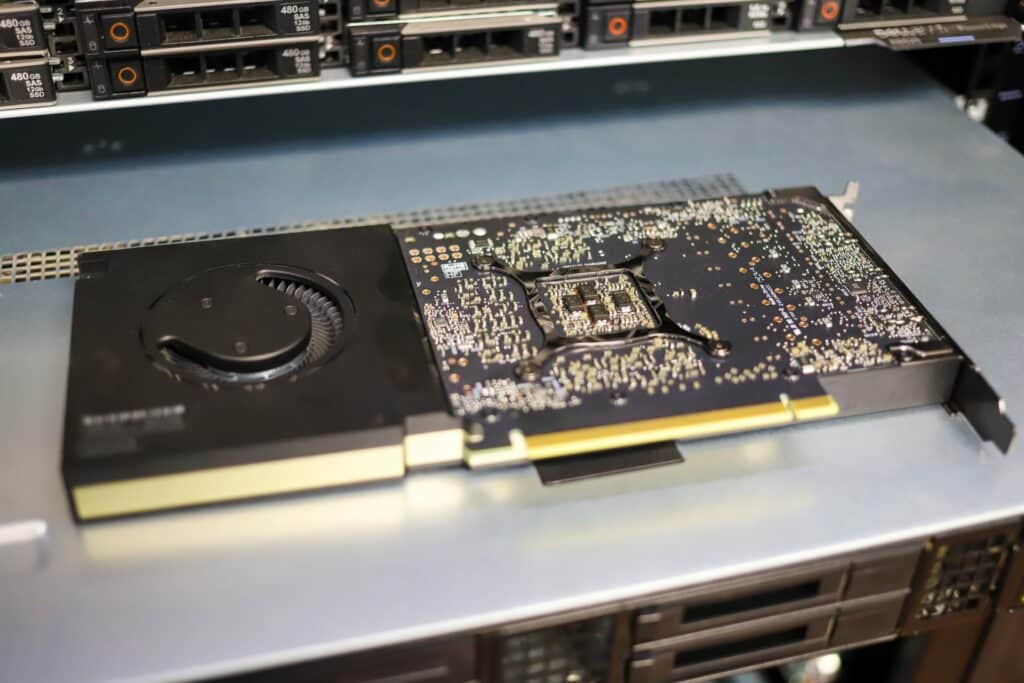
Lenovo ThinkStation P620:
- AMD Ryzen Threadripper Pro 3995WX Processor (2.70 GHz, up to 4.20 GHz Max Boost, 64 Cores, 128 Threads, 32 MB Cache)
- 64GB of DDR4 RAM
- 1TB PM981 SSD
SPECviewperf 2020
First up is the SPECviewperf 2020 benchmark, the worldwide standard for measuring graphics performance of professional applications running under the OpenGL and Direct X application programming interfaces. The viewsets (or benchmarks) represent graphics content and behavior from actual applications, without having to install the applications themselves. These viewsets include 3D Max, CATIA, Creo, Energy, Maya, Medical, Siemens NX, and Solidworks.
| Viewsets | NVIDIA RTX 4000 Lenovo ThinkStation P620 |
NVIDIA RTX A4000 HP ZCentral 4R |
NVIDIA RTX A6000 Lenovo ThinkStation P620 | NVIDIA RTX A6000 HP ZCentral 4R |
| 3dsmax-07 | 90.29 | 90.8 | 131.96 | 127.89 |
| Catia-06 | 67.54 | 58.75 | 90.99 | 75.32 |
| Creo-03 | 103.84 | 90.65 | 125.88 | 99.54 |
| Energy-03 | 21.97 | 22.16 | 42.22 | 38.83 |
| Maya-06 | 224.81 | 215.15 | 314.82 | 273.01 |
| Medical-03 | 22.55 | 21.53 | 34.87 | 30.58 |
| Snx-04 | 322.7 | 328.37 | 450.72 | 422.01 |
| Sw-05 | 107.06 | 108.76 | 161.4 | 152.19 |
For this benchmark, the RTX A4000 showed great performance in both the Lenovo and HP systems (which showed very similar results) due to the new Ampere architecture. You will notice the same trend in the rest of our benchmarks.
Though the performance differential of the higher-end model (A6000) is sometimes significant, the A4000 still offers plenty of performance for most intensive use cases.
Next, we ran SPECworkstation3, a test that specializes in benchmarks designed for testing all key aspects of workstation performance; it uses over 30 workloads to test CPU, graphics, I/O, and memory bandwidth. The workloads fall into broader categories such as Media and Entertainment, Financial Services, Product Development, Energy, Life Sciences, and General Operations. We are going to list the broad-category results for each, as opposed to the individual workloads. The results are an average of all the individual workloads in each category.
SPECworkstation3
| Category | NVIDIA RTX A4000 Lenovo ThinkStation P620 | NVIDIA RTX A4000 HP ZCentral 4R |
NVIDIA RTX A6000 Lenovo ThinkStation P620 | NVIDIA RTX A6000 HP ZCentral 4R |
| M&E | 5.87 | 3.37 | 6.04 | 3.49 |
| ProdDev | 5.01 | 3.35 | 5.49 | 3.63 |
| LifeSci | 3.99 | 3.51 | 4.61 | 3.76 |
| Energy | 4.68 | 2.58 | 5.58 | 2.79 |
| FSI | 9.46 | 3.96 | 9.49 | 3.38 |
| GeneralOps | 2.2 | 1.59 | 2.14 | 1.63 |
| GPU Compute | 5.25 | 5.19 | 7.44 | 7.22 |
Overall, we saw more impressive performance with the A4000 when installed inside the P620, sometimes even offering similar or even better results compared to the A6000 (specifically the general operations and financial services categories). When populated inside the HP ZCentral workstation, the A4000 showed noticeably lower numbers with the exception of the GPU compute category.
Environmental Systems Research Institute (Esri)
Next up is the Environmental Systems Research Institute (Esri) benchmark. Esri is a supplier of Geographic Information System (GIS) software while their Performance Team designed their PerfTool add-in scripts to automatically launch the ArcGIS Pro.
This application uses a “ZoomToBookmarks” function to browse various predefined bookmarks and create a log file with all the key data points required to predict the user experience. The script automatically loops the bookmarks three times to account for caching (memory and disk cache). In other words, this benchmark simulates heavy graphical use that one might see through Esri’s ArcGIS Pro software.
The tests consist of three main datasets. Two are 3-D city views of Philadelphia, PA, and Montreal, QC. These city views contain textured 3-D multipatch buildings draped on a terrain model and draped aerial images. The third dataset is a 2-D map view of the Portland OR region. This data contains detailed information for roads, land use parcels, parks and schools, rivers, lakes, and hill shaded terrain.
First up is Montreal. Here, the RTX A4000 hit an average FPS of 471.31 and a minimum FPS of 194.66 inside the P620. The HP ZCentral 4R configuration showed an average FPS of 349.32 and a minimum FPS of 167.86.
| ESRI ArcGIS Pro 2.3 Montreal | |
| Average FPS | |
| NVIDIA RTX A4000 (ThinkStation P620) | 471.31 |
| NVIDIA RTX A4000 (HP ZCentral 4R) | 349.32 |
| NVIDIA RTX A6000 | 614.03 |
| Minimum FPS | |
| NVIDIA RTX A4000 (ThinkStation P620) | 194.66 |
| NVIDIA RTX A4000 (HP ZCentral 4R) | 167.86 |
| NVIDIA RTX A6000 | 238.18 |
Next up is Philly. Here, the RTX A4000 hit an average FPS of 323.15 and a minimum FPS of 164.68 inside the P620. The HP ZCentral 4R configuration showed an average and minimum FPS of 363.24 and 202.02, respectively.
| ESRI ArcGIS Pro 2.3 Philly | |
| Average FPS | |
| NVIDIA RTX A4000 (ThinkStation P620) | 323.15 |
| NVIDIA RTX A4000 (HP ZCentral 4R) | 363.24 |
| NVIDIA RTX A6000 | 542.70 |
| Minimum FPS | |
| NVIDIA RTX A4000 (ThinkStation P620) | 164.68 |
| NVIDIA RTX A4000 (HP ZCentral 4R) | 202.02 |
| NVIDIA RTX A6000 | 237.54 |
Our last model is of Portland where RTX A4000 had an average FPS of 2,305.81, and a minimum FPS of 790.43 inside the P620. The HP ZCentral 4R configuration showed an average and minimum FPS of 1,694.04 and 637.65, respectively.
| ESRI ArcGIS Pro 2.3 Portland | |
| Average FPS | |
| NVIDIA RTX A4000 (ThinkStation P620) | 2,305.81 |
| NVIDIA RTX A4000 (HP ZCentral 4R) | 1,694.04 |
| NVIDIA RTX A6000 | 2,756.82 |
| Minimum FPS | |
| NVIDIA RTX A4000 (ThinkStation P620) | 790.43 |
| NVIDIA RTX A4000 (HP ZCentral 4R) | 637.65 |
| NVIDIA RTX A6000 | 906.17 |
Blender
Next up is the ubiquitous Blender, an open-source 3D modeling application. This benchmark was run using the Blender Benchmark utility. NVIDIA OptiX was the chosen render method, as opposed to CUDA, as the A4000 (like higher-end A6000) can utilize RTX. In this benchmark measured in seconds, lower is better.
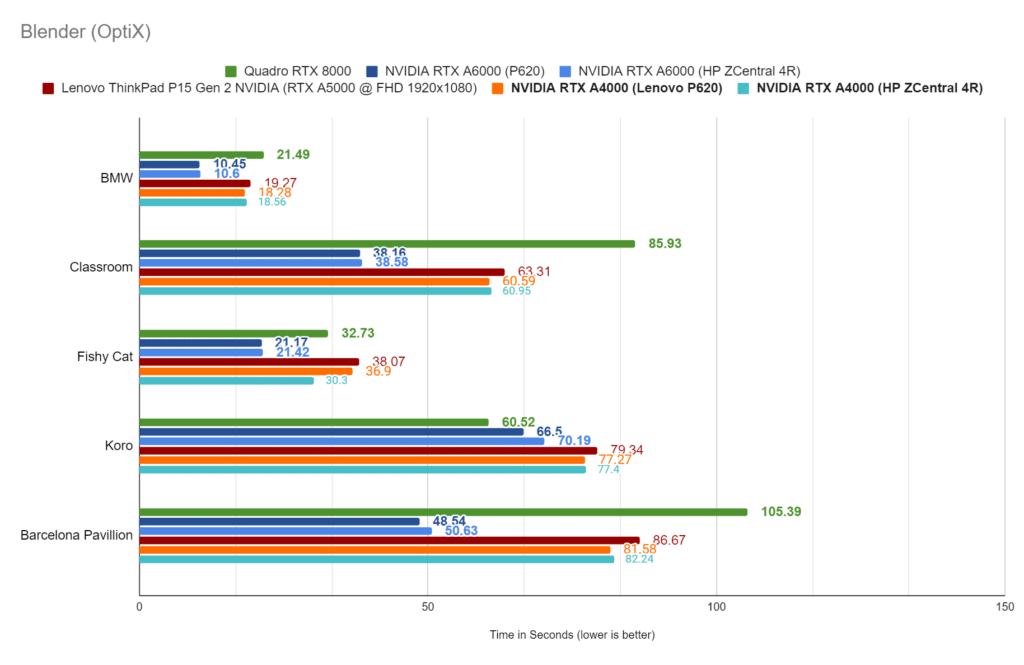
Though the A6000 was almost twice as fast when installed inside the P620 and HP ZCentral 4R, this was expected and the A4000 still showed next-gen results for its class.
LuxMark
LuxMark is an OpenCL cross-platform benchmarking tool from those who maintain the open-source 3D rending engine, LuxRender. This tool looks at GPU performance in the areas of 3D modeling, lighting, and video work. For this review, we used the newest version, v4alpha0. In LuxMark, higher is better when it comes to the score.
Inside the Lenovo P620, the RTX A4000 scored 4,627 In the food rendering category while Hallbench showed 12,314. These were behind most of the tested drives, but again, the results were still good, as the other tested GPUs are equipped with higher-performing components.
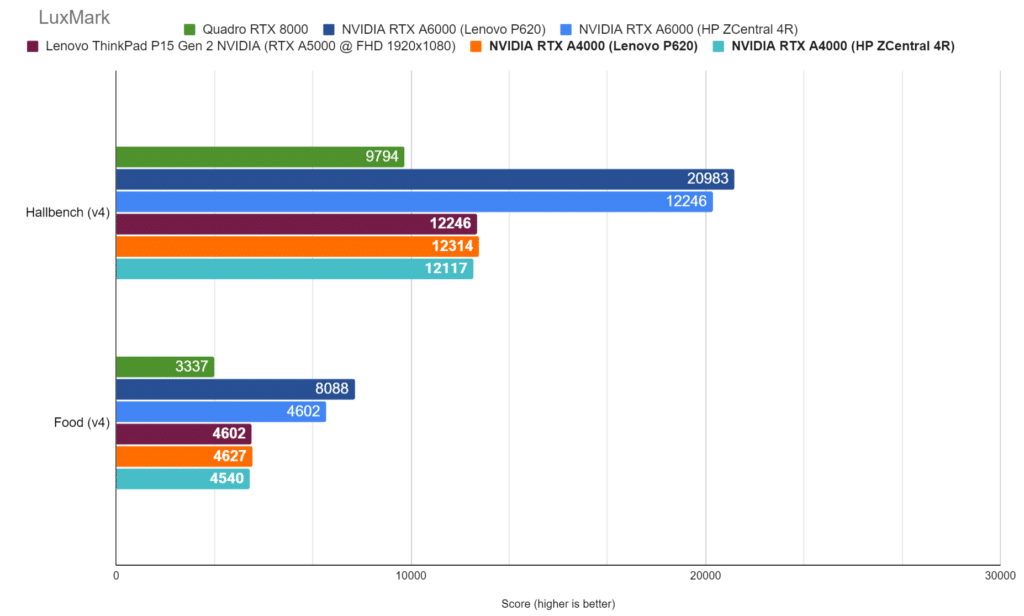
Inside an HP ZCentral 4R, the RTX A4000 posted a score of 12,117 and 4,540 for the food and Hallbench categories, respectively.
OctaneBench
Lastly, we look at OctaneBench. This is a benchmarking utility for OctaneRender and another 3D renderer with RTX support (similar to V-Ray).
| RTX A4000 Total Score: 392.47 | |||||
| Lenovo ThinkStation P620 | |||||
| Scene | Kernel | Ms/ s | Ratio | Weight | Score |
| Interior (by Julia Lynen) | info channels | 239.64 | 4.651 | 10 | 11.63 |
| Interior (by Julia Lynen) | direct lighting | 71.47 | 4.015 | 40 | 40.15 |
| Interior (by Julia Lynen) | path tracing | 35.13 | 4.113 | 50 | 51.41 |
| Idea (by Julio Cayetano) | info channels | 247.17 | 2.874 | 10 | 7.19 |
| Idea (by Julio Cayetano) | direct lighting | 66.43 | 3.156 | 40 | 31.56 |
| Idea (by Julio Cayetano) | path tracing | 60.06 | 3.099 | 50 | 38.74 |
| ATV (by Jurgen Aleksejev) | info channels | 223.54 | 7.121 | 10 | 17.80 |
| ATV (by Jurgen Aleksejev) | direct lighting | 67.25 | 4.421 | 40 | 44.21 |
| ATV (by Jurgen Aleksejev) | path tracing | 57.24 | 4.430 | 50 | 55.38 |
| Box (by Enrico Cerica) | info channels | 259.13 | 3.941 | 10 | 9.85 |
| Box (by Enrico Cerica) | direct lighting | 55.13 | 3.983 | 40 | 39.83 |
| Box (by Enrico Cerica) | path tracing | 48.12 | 3.578 | 50 | 44.72 |
| RTX A4000 Total Score: 391.72 | |||||
| HP ZCentral 4R | |||||
| Scene | Kernel | Ms/ s | Ratio | Weight | Score |
| Interior (by Julia Lynen) | info channels | 238.19 | 4.623 | 10 | 11.56 |
| Interior (by Julia Lynen) | direct lighting | 71.49 | 4.017 | 40 | 40.17 |
| Interior (by Julia Lynen) | path tracing | 35.14 | 4.114 | 50 | 51.43 |
| Idea (by Julio Cayetano) | info channels | 244.42 | 2.842 | 10 | 7.11 |
| Idea (by Julio Cayetano) | direct lighting | 66.26 | 3.148 | 40 | 31.48 |
| Idea (by Julio Cayetano) | path tracing | 59.98 | 3.095 | 50 | 38.68 |
| ATV (by Jurgen Aleksejev) | info channels | 222.32 | 7.083 | 10 | 17.71 |
| ATV (by Jurgen Aleksejev) | direct lighting | 67.12 | 4.413 | 40 | 44.13 |
| ATV (by Jurgen Aleksejev) | path tracing | 57.19 | 4.426 | 50 | 55.33 |
| Box (by Enrico Cerica) | info channels | 257.61 | 3.918 | 10 | 9.80 |
| Box (by Enrico Cerica) | direct lighting | 54.97 | 3.971 | 40 | 39.71 |
| Box (by Enrico Cerica) | path tracing | 48.02 | 3.570 | 50 | 44.63 |
Here, we see an overall score of 392.47 and 391.72 when populated inside the HP and Lenovo workstations, respectively. This is roughly half of what the A8000 is capable of; however, it is an impressive result for an entry-level card and certainly leaps and bounds over its predecessor.
In comparison to higher-end consumer-grade cards, the official OctaneBench website scored the powerful RTX 3070 and 3060 TI and RTX 3080 (laptop model) with 400 and 376, respectively, while the Quadro RTX 4000 showed just 228 in their charts.
Conclusion
The RTX A4000 is NVIDIA’s latest midrange release from its portfolio of professional GPUs based on the second-generation RTX architecture. While the A6000 is an ultimate performer with a premium price tag, the new A4000 is the most affordable card of the line, featuring 6,144 CUDA processing cores, 48 next-generation RT cores, HDCP 2.2 support, and the PCI Express 4.0 x16 interface. It also can connect to a maximum of four 4096 x 2160 displays at 120Hz. This card is meant for professionals who have more modest needs and a smaller budget, though it can still handle a wide range of resource-intensive professional workloads.
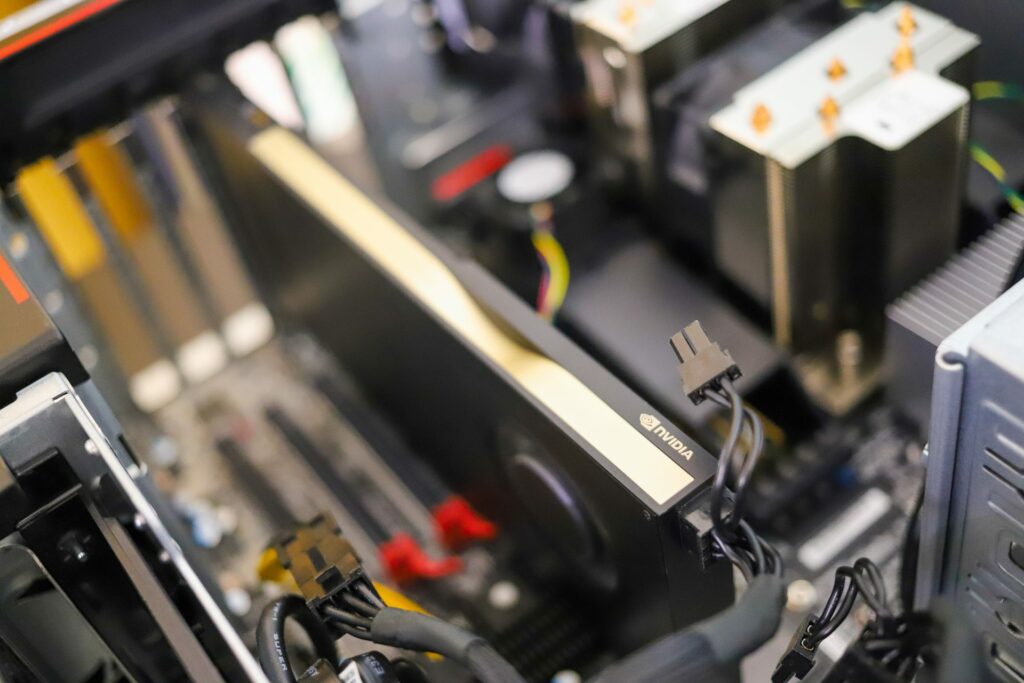
NVIDIA indicates that this is essentially a replacement of the Quadro RTX 4000; but that’s certainly an understatement, as the new A4000 blows it out of the water in every way. Performance is more in line with the desktop version of the well sought-after and powerful RTX 3070. That said, the new NVIDIA card doubles the GPU memory size of the RTX 4000 to 16GB GDDR6, which allows it to perform at a much higher level when dealing with complex 3D datasets.
As we mentioned earlier, this significant boost in performance is primarily due to NVIDIA Ampere, a next-gen architecture that uses Samsung’s 8nm NVIDIA custom process. It’s also highlighted by an improved streaming multiprocessor, 2nd-gen Ray Tracing cores, and considerably better ray-tracing hardware acceleration.
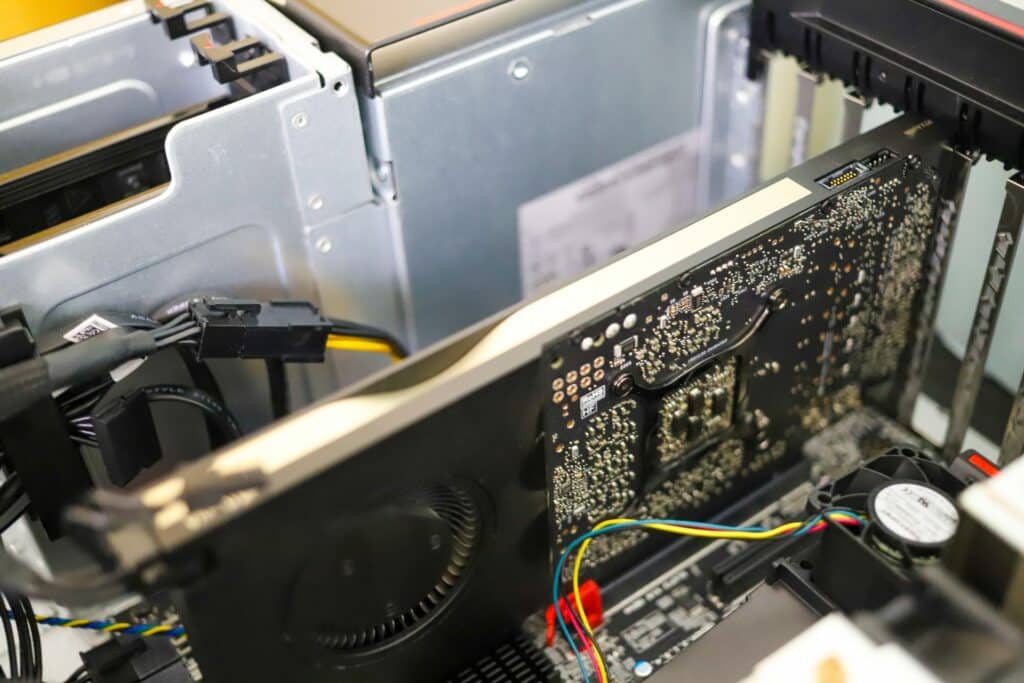
Moreover, Ampere uses 3rd-generation Tensor Cores to which improve AI inference performance while DLSS results in noticeably better performance at higher resolutions. There’s a lot more to Ampere and but all of this simply means the RTX A4000 (like the A8000) is a huge leap forward in GPU technology and even entry cards like this are able to show some huge gains in performance compared to the previous generation. With this release, NVIDIA is giving those who can’t afford high-end workstation GPUs the opportunity access to this impressive architecture.
So, who is the RTX A4000 for? Engineers and architects who use advanced professional applications and don’t need a top-end workstation GPU will certainly find the A4000 an ideal choice for their workloads. Those who need the best performance possible out of their workstation (with a much larger budget to boot) might opt for NVIDIA’s flagship RTX A6000 and A5000 that sits between the two.




 Amazon
Amazon